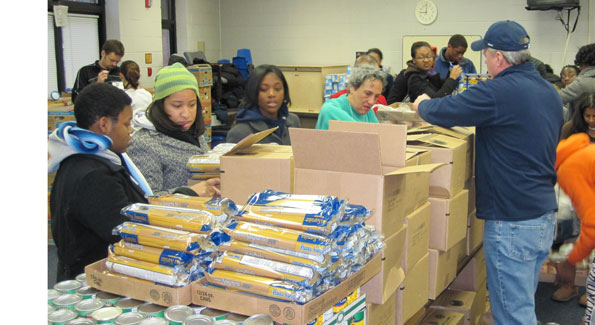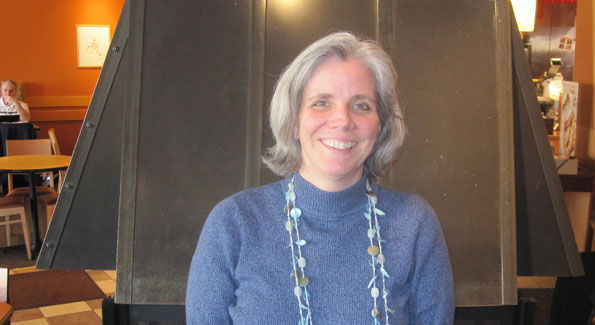The Greater Washington Catalogue for Philanthropy takes the guesswork out of finding a small, local high-impact charity.
By Jane Hess Collins

ALIVE volunteers prepare for a last-Saturday food distribution. ALIVE is one of the Greater Washington Catalogue for Philanthropy's selected nonprofits. (Photo by Jane Hess Collins)
Shopping for anything – handbags, power drills, toothpaste – is never as easy as it sounds. With so many choices, it’s easy to give up and leave empty-handed. Shopping for a charity to support can be equally overwhelming. Luckily, the Greater Washington Catalogue for Philanthropy has done the homework so you don’t have to.
The Greater Washington Catalogue for Philanthropy features 343 of the area’s most high-impact small nonprofits. Founded in 2003 by Barbara Harman, executive director of the Harman Family Foundation, the Catalogue for Philanthropy evaluates local nonprofits with budgets below $3 million to highlight their good work and to introduce them to potential donors.
Although 80% of nonprofits nationally have budgets of 3 million or less, “giving to smaller nonprofits does make people nervous,” said Harman. “The benefit of giving to the smaller nonprofits is that you know your donation is going to have an impact.”
Another benefit is the relationship that may develop between a donor and a small, local non-profit that rarely occurs when donating to a large non-profit. Kathy Jankowski, director of partnerships and business development, says it’s all about trust. “Many people really do want to participate and make a difference. It’s just that they don’t know how and they don’t know who to trust. And we think that if we can play a role in connecting them to who they can trust, they will begin to realize that the money is a tool for social change.”
Eventually, Jankowski added, donors become more involved with the nonprofit through serving as board members or participating in their committees or events.
The real relationship between a donor and a nonprofit develops over time. Jankowski recommends that potential funders first volunteer with the organization and get to know the staff and board members. “There’s no trade off for going in, visiting them, talking to their people, finding out everything you can about them,” she advised.
The relationship should develop from both sides. As potential donors get to know the nonprofit’s leadership, they should ask questions about the program, vision, strategic plan and funding sources. Similarly, nonprofit executive directors and board members should engage with the potential donors by sharing examples of the impact of their work.

Kathy Jankowski, director of partnerships and business development for the Greater Washington Catalogue for Philanthropy, advises donors and nonprofits to build trust-based relationships with each other. (Photo by Jane Hess Collins)
Acceptance into Catalogue for Philanthropy is like getting the Good Housekeeping Seal of Approval, said Jankowski. And acceptance into the Catalogue has other perks as well. The Catalogue has raised over $11.8 million for its featured nonprofits since its inception.
Nonprofits must complete a rigorous application process that is reviewed by 100 volunteers from corporations, foundations, giving circles and peer non-profit organizations. The reviewers study a nonprofit’s purpose, impact, programs, goals, strategic plan and diversity of funding sources. Finally, each nonprofit must discuss why their mission promotes the best values of philanthropy.
Each application is scored on a scale of 1 (outstanding) to 5 (well south of outstanding). Although the cut-off score may vary from year to year, generally only those nonprofits that score a “2” or better are accepted. Currently each nonprofit must re-apply every three years, and by next year the requirement will be bi-annual.
Traditionally, 68 nonprofits are featured in the catalogue each year, which is mailed to select addresses, and all of the accepted nonprofits are profiled on the website.
Harman views the Greater Washington Catalogue for Philanthropy as a “tremendous model for what regional philanthropy could look like around the country as well as our nation’s capitol.” The combination of its hard-copy catalogue and interactive website offer a navigable amount of information on regional philanthropy that does not overwhelm.
Any plans to expand nationally? “Sure,” says Harman. The key, she says, it to perfect the greater Washington model and then take it to other parts of the country.
And that could take the guesswork out for everyone.
Upcoming story alert: Spring is here and it’s time for romance! If you’ve ever found love while doing volunteer or charity work, please email your story to me at jane@getoutandgiveback.com




